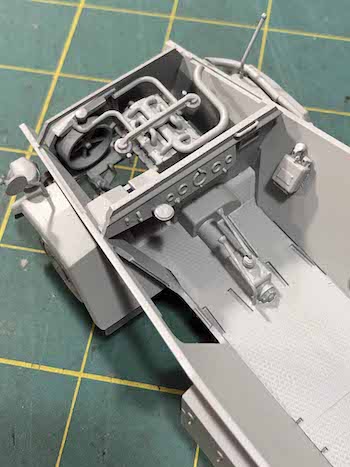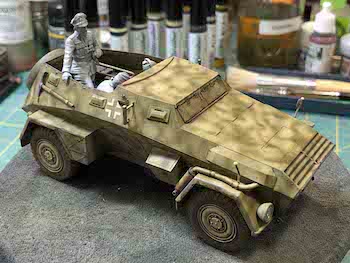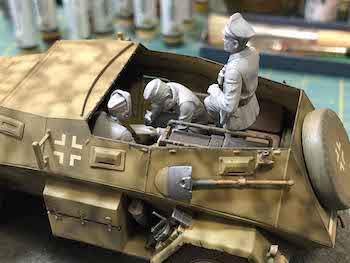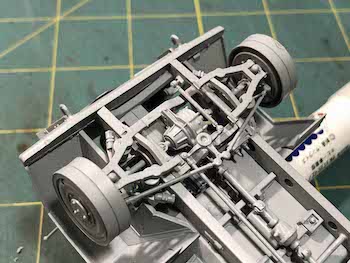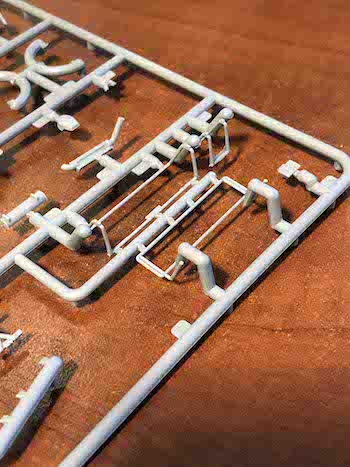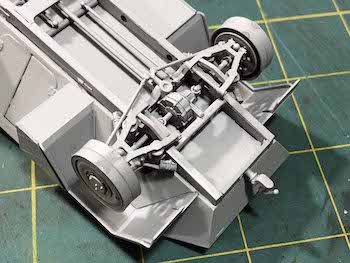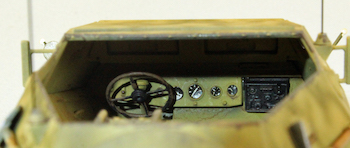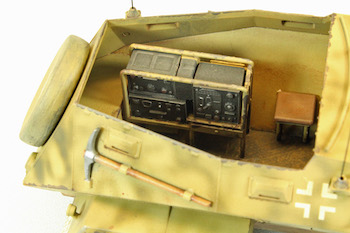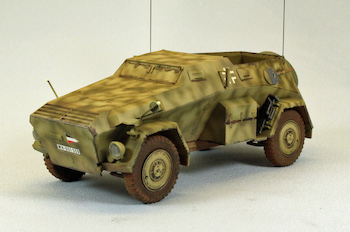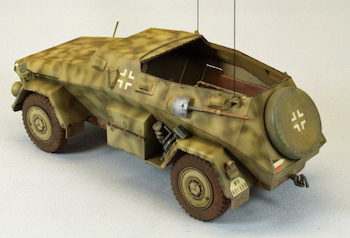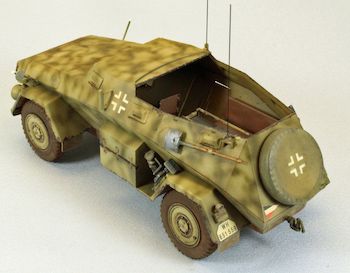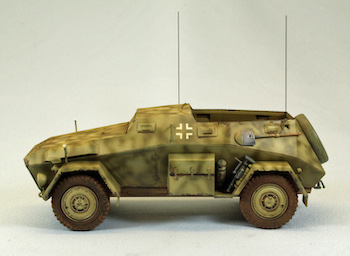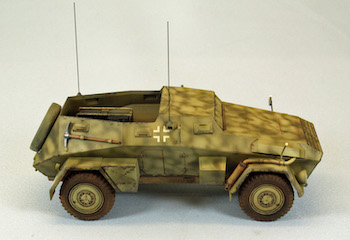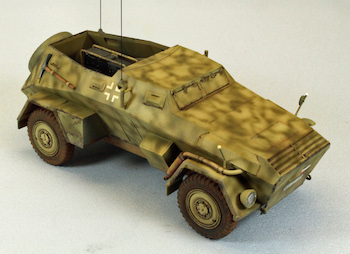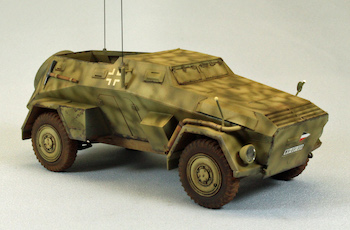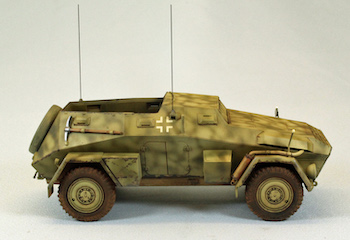
Reviews
Armor
German Sd.Kfz. 247 Ausf B with Crew
by Eric Christianson
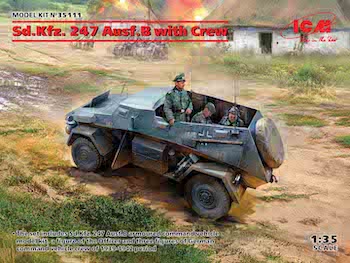 Model: German Sd.Kfz. 247 Ausf B with Crew
Model: German Sd.Kfz. 247 Ausf B with Crew
Reviewed by: Eric Christianson, IPMS # 42218
Scale: 1/35
Company: ICM
Price: $65.97
Product/Stock #: 35111
Website: ICM
Product Web Page: View
Product provided by: MBK Distribution
History
This new ICM offering represents an unusual mark in a family of Sonderkraftfahrzeug (Sd.kfz.) ‘special purpose vehicles’ fielded by the German Wehrmacht in World War II. The diminutive Sd.Kfz. 247 was an armored staff car outfitted with radio gear, intended for use by the commanders of motorcycle and motorized reconnaissance battalions. The Ausf B version represented in this kit, was one of 58 built by Daimler-Benz between 1941—1942 on a four-wheel drive heavy car chassis (s.Pkw. Type 1c). The front-mounted engine was an 8-cylinder, 3.823-litre (233.3 cu in) Horch 3.5 petrol engine, giving it a road speed of 80 km/h (50 mph). It had a maximum range of 400 km (250 mi). Although unarmed, its armor was intended to stop 7.92-millimetre (0.312 in) armor-piercing bullets at ranges over 30 meters.
The Kit
As far as I know, this is the only injected plastic kit of this vehicle; the only other one a short-run, multi-media kit from Sovereign. The first thing I noticed about ICM’s release was the unusual box. The kit is shipped in a sturdy, white ‘locking’ clamshell box. But instead of sliding a simple sleeve over the box, ICM drops a standard model box top over it. The overall impression is one of sturdiness. Since the kit is not shrink-wrapped, the double layering helps to ensure that nothing will be lost in transit. Nice start. Once open, all parts are bagged and the decals are slipped inside the instruction booklet. The tires are molded in poly-vinyl, and the four figures included in the kit are bagged separately (more on these later). The plastic is soft but not too soft, and the molding is excellent with no noticeable flash or sink marks. The detail is crisp and the number of attachment points and nodes, while many, are located in areas that are easily addressed.
The contents of the box include:
- Four sprues of parts molded in dark-grey plastic
- 4 vinyl tires
- 1 medium-sized decal sheet
- 1 28-page, full-size color instruction booklet, including a parts map and four three-view color painting and decal guide. All text and label
- information are translated into English.
- 1 two-sided color instruction sheet and painting guide for the figures
- Markings for Four Vehicles, all WWII German Wehrmacht
The Instructions
The instruction booklet is excellent. Printed in color on high-quality, satin-finish paper, it starts off with a short history and vehicle specifications, color reference information, contact information, and an excellent parts map. What follows is a two-color set of instructions broken into 113 well-illustrated, small steps. Images are rendered from several angles so you are never forced to guess about how things go on ‘the other side’. The last two pages show four, full-color three-views of camouflage schemes – three German grey and one German dark yellow, spanning 1941 through 1944.
A separate full color sheet of instructions walks you through the assembly and painting of four figures; a driver, two radio operators, and an officer.
Clearly ICM has invested heavily in making an excellent set of instructions, and the quality shows through. Good job.
What to Consider Before You Start
There is a decent amount of detail that is visible on the finished model even if you do not leave any of the doors, hatches, and widows open (which are build options). This means there will be a few more painting steps than with a closed-top vehicle which could cause you to deviate from the instructions as needed.
The wheels can be assembled and attached without the tires, which can be slipped on at the very end of the build, after painting and weathering.
On two of the paint schemes illustrated, there is a German cross (balkenkreuze) that lies underneath the shovel. If you are like me and paint the pioneer tools in situ, you will need to accommodate that when the time comes.
Otherwise, this kit seriously has no ‘gotchas’ or other odd things to trip up on, even for new modelers.
The Build
I haven’t built an ICM kit in a while, and I have been told that their new moldings are spectacular, so I have been looking forward to building this kit ever since it popped up on the review list. Now that I have finished, I am a real fan – ICM deserves a lot of kudos for such a great effort in engineering and design here.
Assembly starts with the lower chassis, which is quite detailed and built in layers.
The frame is formed from two parallel I-beams with several cross members. I was pleased with how this went together; ICM has made an easy task of what has been a finicky chore from other manufacturers. Each cross member can firmly be attached to (either) side, forming solid fit when brought together - no wobble here. Some parts, such as E12 (Step 9) and C45 (Step 12) come as exquisitely-detailed single parts (!) instead of a handful of poorly fitting bits and pieces.
Steps 30-34 will have you attach the tires to the wheels. I chose to leave that step until the end, after painting and weathering – the tires will easily slip on the wheels from the outside.
In Step 47, the front radiator and fan fit into a groove in the port sidewall. Since this part also defines where the top of the front hood rests, I chose to leave that part out until Step 95, when the top and bottom of the vehicle are brought together and I could make sure the radiator did not interfere with the fit of the hood. As it is, I could have left off entirely since the area is covered up with an armored plate.
The main doors (single on the port side, double doors on the starboard side) can be modeled open or closed, as can all the window and access vents throughout the vehicle. The interior detail of the doors is light so you might want to beef that up if you choose to leave them open.
If you choose to close them, the fit is perfect, aided by a set of very thin plastic shims that are molded there as building aids. Nice. The fit of the lower chassis and the lower half of the vehicle – always a toss-up on trucks and other AFV’s with busy undercarriages – is perfect on the -247. From every angle, the seal is flat and solid. Great engineering here.
Likewise, the assembly of the interior benches, chairs and radio racks (could) have been a real fiddley headache, but not in this kit. ICM really excels here. Each assembly has enough parts to make things interesting, but doesn’t overwhelm the builder with dozens of odd little bits. The hardest part about the interior is the finish – as it should be.
Each of eight visors come with interior hardware in case you wish to model them open.
The busy engine can be viewed only through a narrow hatch on top. I didn’t feel that the view warranted an all-out effort on finishing the engine, so I left it closed like all the other hatches. Even so, a lot of interior detail can be seen looking down from above. The front headlights are attached via small dimples in the fenders. I felt I could get a sturdier connection by drilling some holes for those, as well as for some of the other ‘protuberances’ up front – there are quite a few!
I looked at the three-part exhaust muffler in the instructions and thought ‘these are going to need some extra work since they are right up top and front, and likely to show gaps’. Not so! Once in place, they look like they were drawn on the vehicle – a perfect fit.
I felt that the two antennae were a little over-scale so I replaced them with .010" carbon fiber attached with a drop of epoxy.
The jack (just three parts!) is detailed enough as is – I think this is a record for the fewest parts for a German jack I have ever seen in a modern model kit!
And then I was done – in three short modeling sessions. This little guy was ready for paint.
Painting, Decals and Finish
I decided to paint my SdKfz 247 in an overall German yellow scheme with late-war dark green mottling. I used paint and finishes from a variety of manufacturers, listed below.
Before painting, I made a sticky board of all the parts that were finished separately. These included the radio racks, spare wheel, steering wheel and seats.
I started by applying a coat of (rattlecan) Krylon Flat Black Paint/Primer for my dark, primer/pre-shade coat. Surprisingly, this low-cost enamel solution sprays on easily and dries very thin and tough – replacing a time-intensive task I normally use an airbrush and more expensive paint for. I use a dark primer coat to give the plastic and PE some grip, and to fill in the recesses - creating a shadow effect near the flat surface edges and adding depth for subsequent coats to come.
After the primer had degassed, I followed the pre-shade coat with AK Interactive Real Colors RC062 Dark Yellow (Variant), a slightly ‘richer’ hue than the standard Tamiya Dark Yellow. I followed that with a post-shade coat of Mig Ammo -11 DunkleGelb Aus. 44DGI acrylic – a light German yellow shade, thinned 50/50 with Gunze SLT. I tried to go light near the panel lines so that some of that dark from the pre-shade would show through. I finished the camo scheme with a mottling layer using AK Interactive Real Color RC048 Field Grey thinned 50/50 with Gunze SLT. I like these AKI Real Color and Mig Ammo paints because they cover all the color variations I need right out of the bottle – no need to mix lighter shades, etc., making the colors easier to replicate from model to model.
With the basic scheme down, I went to work on the detail painting. Vallejo Leather Brown mixed with Buff for the seats and steering wheel, Tamiya NATO Black and Uschi Chrome pigment for the radio sets and jack. I used Vallejo 311 New Wood and Tamiya Flat Black for the pioneer tools. These would be weathered with Mig Oils and Uschi Chrome pigment later. I globed some Tamiya Gloss black on the ends of the shifters, and Gloss White on the ends of the curb telltales.
Next, I hand-painted the exhaust pipes and muffler with Lifecolor 702 and 703 Rust in a random pattern. Once that was dry, I brushed on a layer of Mig Chipping Fluid followed by a coat of Tamiya Dark Yellow so that I could work off some of the base coat coming up to show some wear.
I gave the entire vehicle a healthy filter of Mig Oil Wash Brown, followed by a detail workover with Vallejo Cam Medium Black Brown to represent chipping. Once satisfied, I laid down several coats of Pledge floor polish (Future) to prepare the surfaces for washes and decals.
I applied the decals using Red and Blue MicroSol/MicroSet without any problems. The ICM decals are thin and separate from the backing effortlessly. Once the decals were dry, I applied a wash using Mig Oil Shadow Brown to the entire vehicle. When I got to the wheels, I laid the vehicle on its side to allow the wash to dry evenly. I covered the wooden portions of the pioneer tools with un-thinned Mig Oil Wash Brown and let that sit overnight to soak in before wiping off the excess the next morning with a Q-tip.
I followed this with a ‘road-dusting’ coat of Vallejo Model Air Light Brown and then shot the whole vehicle with Vallejo Flat Varnish to kill any shine left over.
I finished the vehicle by attaching the clear headlight lenses with Mig Ultra Glue and inserting .010” carbon fiber replacements for the kits antenna. Done!
Conclusion
I must say, building this kit has made me a new fan of ICM. The design and engineering throughout show through to the modeler in terms of buildability and, as hokey as it sounds - pure model-building fun. Starting with the intelligent use of boxing and sprue to protect the parts, to the broad and consistent use of hidden connection points and modeler-assists, to the design of assemblies that other manufacturers are challenged by, such as with the undercarriage, engine and seats. ICM was able to bring together a nice, little detailed kit without the use of photo-etch or other finicky additions. And the instructions are flawless.
For these reasons I would recommend this kit for all modelers, regardless of experience level, as long as they go slowly and follow directions. This is an unusual vehicle and will no doubt attract a lot of attention on the showroom tables or in your glass case at home.
I would like to thank ICM and MBK-USA for providing this kit for review, and to IPMS USA for giving me the opportunity to build it.

